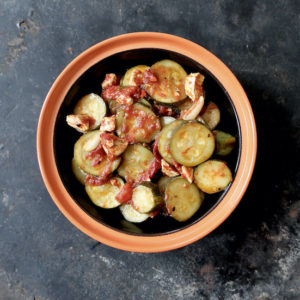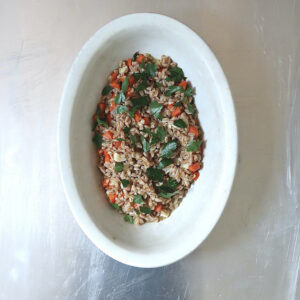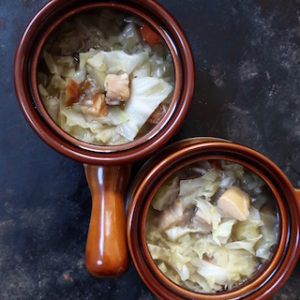Summer Vegetable Saute
So far as I can tell, people are responding to the pandemic in two ways. The first group Marie Kondos everything in sight, moves on to reading all of Tolstoy and/or Proust, then tackles that novel they’ve always meant to write.
All of these accomplishments are shared on social media, of course.

The second group doomscrolls and plunges into depression.
I’m sure you can tell which group your hostess falls into.

I share because I suspect the Marie Kondoing Proustions, by virtue of their sunny enthusiasms, may be getting more airtime than the doomscrolling depressives.
After all, when your house resembles Miss Havisham’s and you’ve been wearing the same sweats for weeks, your first inclination isn’t to share, anywhere.

Cucamelons. I have no photos of disheleved sweatpant wearers, least of all me.
So, look, if you are watching, bewildered, as people engage in old-fashioned pastimes like dining, travel, and recreational shopping, you are not alone. If you fear engaging in these behaviors yourself due to a highly contaigous, incurable pandemic, well, you just may be onto something.
As for that third group who dignifies themselves by publiciy acting out, well, enough said about them.

—
This vegetable sauté really isn’t a recipe. Instead, it’s a way of thinking about cooking whatever summer vegetables are fresh from your garden or market. Wash, trim any nasty bits, slice, and sauté with a little butter or olive oil, a squeeze of fresh lemon, and a crushed garlic clove (or two). If the pan looks dry, add chicken broth, Vermouth, white wine, or plain old water.

These sautés can be corn, tomatoes, summer squash, fava beans, fresh peas, the list goes on. You can cook your vegetables into they’re barely done, or stew them into a sweetly jammy tangle. The choice is yours.

Variations are endless–crumble in a cheeses like feta, goat, or parmesan, add a little (or a lot) of dried red pepper flakes, or scatter sumac and black pepper over the dish. As I was preparing this post, cookbook author Roopa Gulati posted an Instagram recipe for Ginger-spiced courgettes, peppers, and onions. Watch her demo, drool, then season your vegetables with Kashmiri pepper, cumin, and garam masala. (Courgettes, American friends, are zucchini.)

This vegetable sauté also works well with rice, pasta, or any mixed grains. It’s wonderful piled into a roll. Any leftovers are tomorrow’s lunch.

Summer Vegetable Sauté
Amounts depend on how many people you’re cooking for, the vegetables you’re using, and whether you want leftovers. I cook for two modest eaters, so use little more than a handful of each vegetable.
Cooking time depends on whether you prefer vegetables just done, cooked through, or softened to a jammy consistency; roughly 5-20 minutes.
Suggestions:
corn
fava beans
peas
okra
onion
peppers
summer squash/zucchini
tomatoes
fresh lemon or lime juice
garlic cloves
vegetable oil: olive, canola, or sunflower
white wine or Vermouth
chicken broth
butter
salt, pepper
As noted above, this is less a recipe than a way of thinking about summer vegetables, so I’ll give an idea of what’s pictured here. I used one summer squash, a round variety, a handful of cherry tomatoes-maybe 1/4 ounce/25grams, roughly the same amount of cucamelons (we wanted to taste them; think cucumber crossed with watermelon), three large garlic cloves, and some fava beans. (Cooking favas discussed below).
I used the juice of a lemon, olive oil, and some Noilly Prat Vermouth to keep the pan moist. The pan is a Netherton Foundry Prospector Pan. It was a gift from my husband.
I washed, trimmed, and sliced the vegetables, then placed the pan over low heat, added the lemon juice, olive oil (about two tablespoons), and around a 1/4 cup/25ml of Vermouth. I tossed all the vegetables in at once, raised the heat to medium, added salt and pepper, then let everything cook down. John ended up working a bit later, so I moved the pan to a small burner, put it on the lowest heat, and covered it.
In all, the vegetables sat on the stove about an hour. We ate it with David Lebovitz’s Chicken Lady Chicken, from My Paris Kitchen, and basmati rice.
Leftovers may be refrigerated up to three days. Freezing is not recommended.
Note:
Variations are endless: add goat, parmesan, or feta cheeses; vary the spicing, add fresh herbs like parsley and/or cilantro. A dollop of sour cream or creme fraiche has its place.
Seasonings, as mentioned in the post, can run from simple salt and pepper to hot pepper or sumac; modify the dish to suit your tastes and whatever else is being served.
To prepare fava beans: remove from pods, then drop beans into a pot of simmering water. Cook for 3-5 minutes, depending on the size and age of your beans; older and larger means longer cooking. Strain the beans. Once they’re cool enough to handle, peel the outer skins off the beans. They should come off easily. The favas are now ready for further cooking or may be eaten as is.





